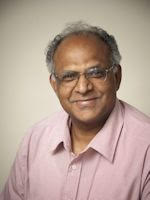Cambridge 7th to 9th September

Presenting Author:
Animesh Jha
<a.jha@leeds.ac.uk>
article posted 13 Mar 2015
Animesh Jha
Professor Animesh Jha is a Professor for Applied Materials Science in the Faculty of Engineering
at the University of Leeds. As part of this role he is the Leader of the Photonic Materials & Devices,
Rare-earth Materials, Minerals and Processing research group and has special interests in thermal analysis,
glass and glass ceramic processing, optical fibre and wave guide engineering and Laser based Spectroscopic
analysis of Rare-earth doped materials.
Professor Jha is the programme leader for an EPSRC and EU project to engineer new dental materials and
perform ex-vivo and in-situ mouth appliance trials. As part of this work, he is overseeing research on the
interaction of lasers with biomaterials for applications in dentistry.
Professor Jha was awarded a Bachelor of Engineering from the University of Roorkee (India) and a
Masters in Engineering from the Indian institute of Science in Bangalore. He completed his PhD
at Imperial college, London.

Interaction of near-IR pulsed Lasers with Biomineral Gels
for Enamel Restoration
A.D. Anastasioua, C. Thomsonb, T. Edwardsb, S.A. Hussainb, O.P. Estevanc, C.T.A. Brownb, A.P. Brownb, M.N. Routledgec, W. Sibbettb, Animesh Jha*a
Tooth hypersensitivity is an acute oral condition, both in children and ageing population worldwide. The symptom arises as a result of continual erosion and loss of the tooth enamel. Since the oral condition affects quality of life of the patients, by not complying with certain types of food and nutrients in long term affects systemic health. In order to minimise the long term health issues, there is an urgent need to provide a robust solution for restoring lost enamel, a problem that remains intractable for clinical dentistry.
Our research is on calcium phosphate minerals mixed with orthosilicate gel for making a homogeneous suspension which is adherent on dentine surface. The structural and thermal analysis of gel materials and their suspension properties will be reported. In this presentation the experimental data on the interaction of continuous wave (CW) and ultra-fast femto-second pulsed (fs) lasers in the near IR (800-1520 nm) range with the suspension of mineral gel will be explained, based on the interaction in the linear regime of photon absorption. The influence of input radiation density, pulsed laser repetition rate and the resulting spontaneity of change in materials absorptivity are explained. Such a coherent radiation induced change leads to photo-activated process of materials phase reconstitution and transformation.

A comparison between the non-irradiated bio-mineral gel suspension layer in Fig. 1a with that of the irradiated samples using 1 kHz (Fig. 1b) and 1 GHz (Fig. 1c) repetition rate fs lasers operating at 800 nm and 1010 nm, respectively is presented. In both examples of irradiation process, the laser irradiation has caused a clear modification of the original bio-mineral layer with flakes of brushite crystals which was applied onto acid-eroded bovine surface as a gel, which spontaneously breaks down and reforms as a new mineral phase which we have identified as beta-calcium diphosphate (Ca2P2O7). In the case of the 1 kHz laser the modified surface seems to be quite porous, as a result of ablation which is the dominant process. On the other hand, the results from the 1 GHz indicate the formation of reconstituted and recrystallized bio-mineral showing a homogeneous layer (Fig. 1c) which is the result of ultrafast transformation and melting of the biomaterial.
References:
1. Elmadani, E., et al. (2012). "Characterization of Rare-Earth Oxide Photoactivated Calcium Phosphate Minerals for Resurfacing Teeth." Journal of the American Ceramic Society 95(9): 2716-2724.
Institutions:
a Institute for Materials Research, School of Chemical and Process Engineering, University of Leeds, UK
b School of Physics and Astronomy, University of St. Andrews, UK
c Institute of Cardiovascular and Metabolic Medicine, School of Medicine, University of Leeds, UK
